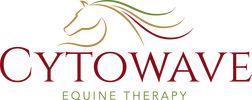|
Due to the advances in nutrition, diagnostics, and detecting and treating various illnesses, it should come as no surprise that horses and companion animals are living longer.
"We're seeing more cases of canine dementia and in fact, more healthy and active senior clients because the medicine has improved so much, and it allows them to live longer," said Monique Pierpont, co-owner of Harmony Animal Hospital (video below), and owner of Nose Prints, Inc. . Horse are no different. An article written by Michael Blanding, "The Old Gray Mare," (Tufts Veterinary Medicine magazine) delves into the reasons why horses are living longer and healthier. What does Cytowave have to do with living longer? Because Cytowave has the ability to reduce swelling and deep tissue inflammation, it aids in the recovery from injuries and the aches and pains typically experienced as one gets older. We have a number of clients who use the back applicator strictly for aches and pains and helping their horses recover from riding and / or training. Just because your companion animal, whether it's a horse, dog or cat, is growing older, it doesn't mean their quality of life has to suffer. Embracing new technologies such as Cytowave to relieve pain is one way to ensure your four legged family members are comfortable.
If you have any questions, or wonder if Cytowave Therapy is right for you and your horse, give us a call! We'll discuss what options you have in healing your horse with Cytowave!
0 Comments
"We've found that many of our clients start by treating a tendon or ligament, then something else comes up," said Kaylynne Brennan, a horse gal and Southeastern Sales Territory Manager. "In this case, Arindel Farm had a horse that had a condylar fracture that they decided to treat with Cytowave."
Although Cytowave is most known for its ability to heal tendon and ligament lesions, it also has a fracture program. And based on the results of treating this fracture, it might soon become one of the more popular treatment programs. Unspoken Spoke had a condylar fracture on/around May of 2014. The Arindel manager at the time, Jolane Weeks, stated that they would usually treat a fracture with 4 months of stall rest, and then 60 days of small pen turnout. Then they would resume rehabilitation and eventually, a return to racing. In the case of Unspoken Rule, the time frame from beginning Cytowave treatments to returning to racing was 7 months. That's a minimum of five months faster than they would have experienced with the older methods and modalities. Watch the video below to hear Jolane discuss the results of the fracture treatment.
"We're just really excited, not only about the Cytowave technology, but the results our clients are getting," said Kaylynne. 
Kaylynne Brennan is Cytowave's South Eastern Region Territory Manager and can be reached at [email protected] or 352-209-6478. |
Archives
February 2018
Categories
All
|

 RSS Feed
RSS Feed
